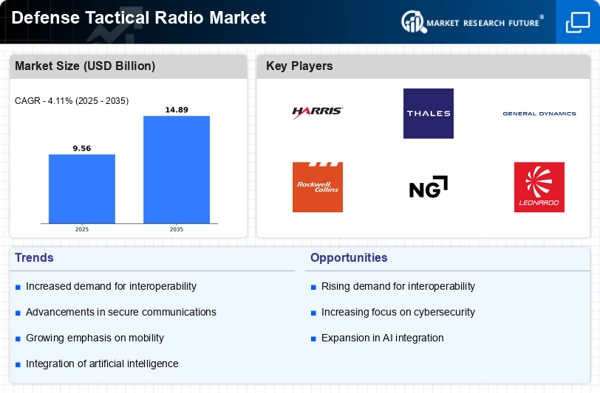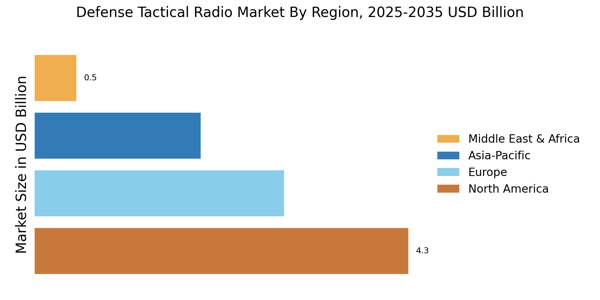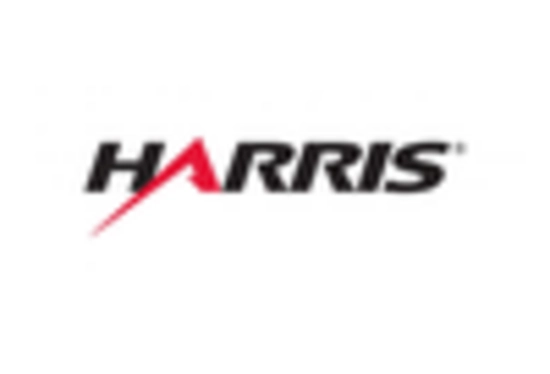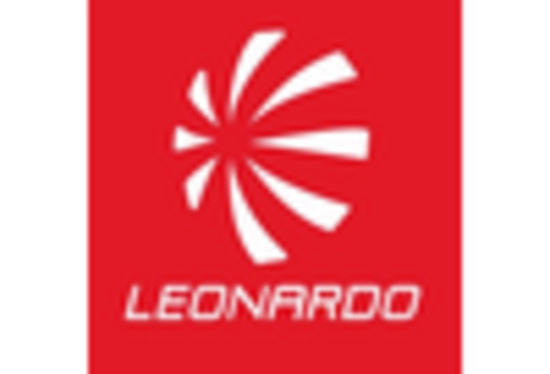Focus on Interoperability
The Defense Tactical Radio Market is witnessing a growing emphasis on interoperability among allied forces. As military operations increasingly involve joint missions, the need for seamless communication between different branches of the armed forces and allied nations becomes paramount. Tactical radios that support interoperability standards are in high demand, as they enable effective collaboration during operations. This trend is further supported by initiatives aimed at standardizing communication protocols across allied forces. The ability to communicate effectively with partner nations enhances operational efficiency and situational awareness, which are critical in modern warfare. Consequently, the Defense Tactical Radio Market is likely to experience growth as manufacturers develop radios that meet interoperability requirements, ensuring that military units can operate cohesively in diverse environments.
Increased Defense Budgets
The Defense Tactical Radio Market is likely to benefit from the increasing defense budgets observed in various nations. Governments are prioritizing military modernization and readiness, which includes upgrading communication systems. As nations allocate more resources to defense, the demand for advanced tactical radios is expected to rise. For instance, recent budget proposals in several countries indicate a focus on enhancing communication capabilities, which directly impacts the procurement of tactical radios. This trend suggests a robust growth trajectory for the market, as defense agencies seek to equip their forces with state-of-the-art communication tools. The emphasis on improving operational capabilities through enhanced communication systems is likely to drive investments in the Defense Tactical Radio Market, fostering innovation and competition among manufacturers.
Rising Geopolitical Tensions
The Defense Tactical Radio Market is influenced by the rising geopolitical tensions observed in various regions. As nations face increasing security challenges, there is a heightened focus on military preparedness, which includes the enhancement of communication systems. Tactical radios play a crucial role in ensuring effective communication among military units during operations. The ongoing conflicts and territorial disputes have prompted countries to invest in advanced communication technologies to maintain a strategic advantage. This trend is likely to drive demand for tactical radios, as military forces seek to improve their operational capabilities. The Defense Tactical Radio Market is expected to see growth as nations prioritize secure and reliable communication solutions in response to evolving threats.
Emerging Demand for Secure Communication
The Defense Tactical Radio Market is increasingly driven by the emerging demand for secure communication solutions. As cyber threats and electronic warfare capabilities evolve, military forces are prioritizing secure communication channels to protect sensitive information. Tactical radios equipped with advanced encryption and anti-jamming technologies are becoming essential for modern military operations. The need for secure communication is underscored by the growing reliance on digital communication systems, which are vulnerable to interception and cyber attacks. As a result, defense agencies are investing in advanced tactical radios that offer enhanced security features. This trend indicates a robust growth potential for the Defense Tactical Radio Market, as manufacturers innovate to meet the stringent security requirements of military operations.
Technological Advancements in Communication Systems
The Defense Tactical Radio Market is experiencing a surge in technological advancements, particularly in communication systems. Innovations such as software-defined radios (SDRs) are enhancing the capabilities of tactical radios, allowing for greater flexibility and adaptability in various operational environments. The integration of advanced encryption methods and improved signal processing techniques is also contributing to the overall effectiveness of these systems. As military forces increasingly rely on secure and reliable communication, the demand for sophisticated tactical radios is expected to rise. Reports indicate that the market for SDRs alone is projected to grow significantly, reflecting the broader trend of modernization within defense communication systems. This evolution in technology not only enhances operational efficiency but also ensures that military personnel can maintain secure lines of communication in complex scenarios.


















Leave a Comment